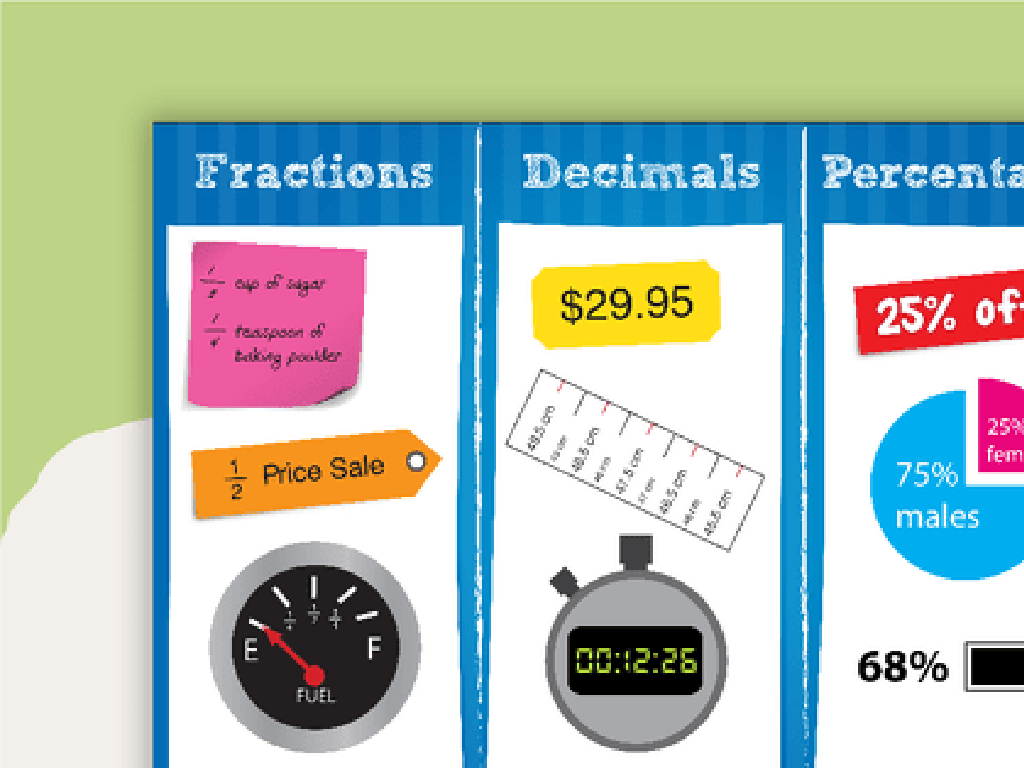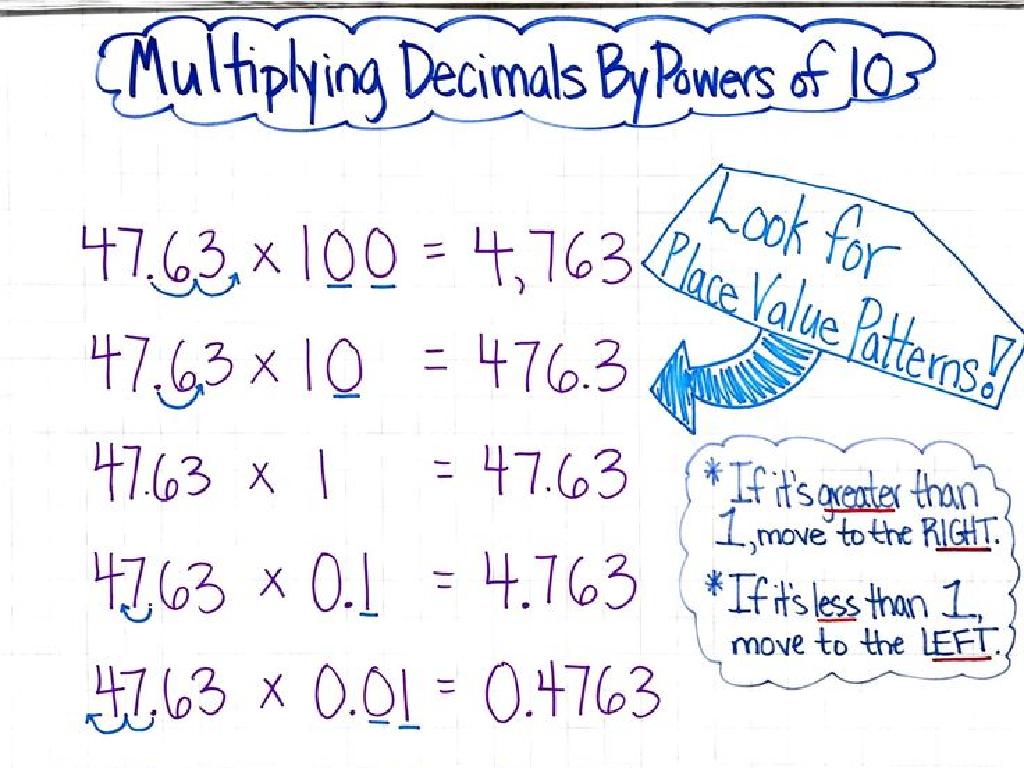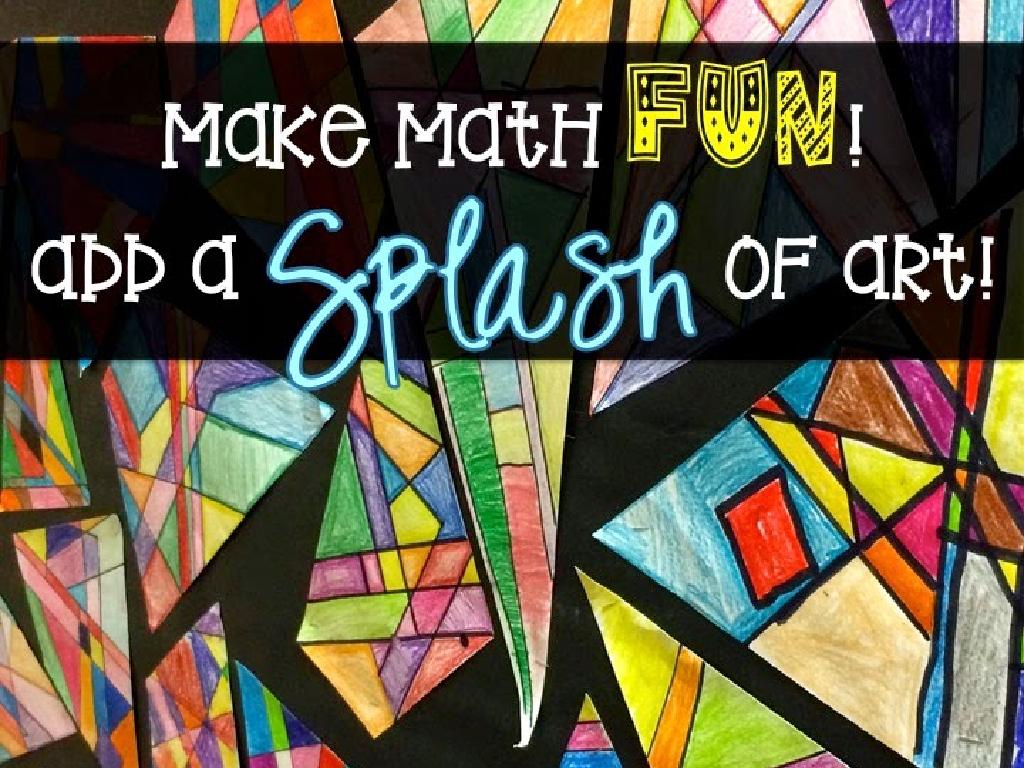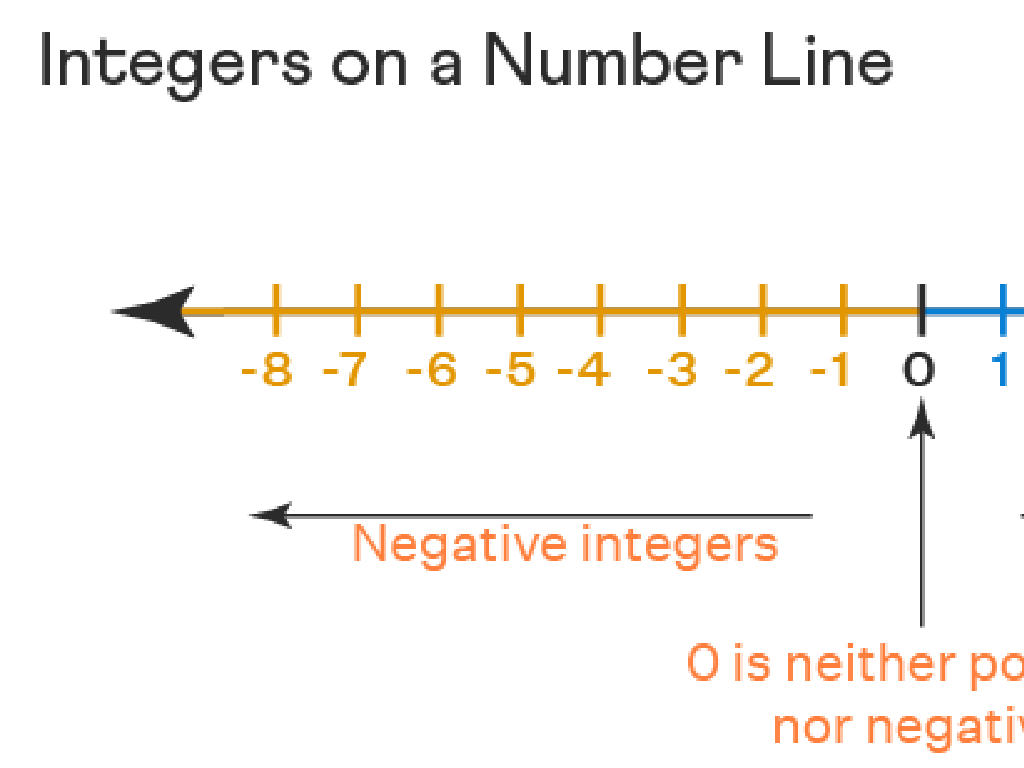Coordinate Planes As Maps
Subject: Math
Grade: Sixth grade
Topic: Coordinate Plane
Please LOG IN to download the presentation. Access is available to registered users only.
View More Content
Using Coordinate Planes as Maps
– Explore the coordinate plane
– A grid with horizontal (x-axis) and vertical (y-axis) lines
– Coordinate planes and maps
– Similar to a map’s latitude and longitude
– Today’s objective: map usage
– Learn to locate points using coordinates
– Practical applications
– Use in treasure hunts or navigating school
|
This slide introduces students to the concept of coordinate planes and their similarity to maps, setting the stage for understanding how to navigate using coordinates. Begin by explaining the basics of the coordinate plane, including the x-axis and y-axis, and how they intersect at the origin. Draw parallels between this system and geographical maps that use latitude and longitude. The learning objective for today’s lesson is for students to apply their understanding of coordinate planes to locate specific points, akin to finding a location on a map. Engage students with practical examples, such as using a coordinate plane to plan a treasure hunt or to navigate around the school. This will help them grasp the real-world relevance of coordinate planes.
Exploring the Coordinate Plane
– Define the coordinate plane
– A two-dimensional surface for plotting points, lines, and curves using a pair of numbers.
– Explore the X and Y axes
– The X-axis is horizontal, Y-axis is vertical, and they intersect at the origin.
– Understand the origin point
– The origin is the central point (0,0) where the X-axis and Y-axis meet.
– Coordinate plane as a map
– Just like a map helps you find locations, a coordinate plane helps to locate points using coordinates.
|
This slide introduces the concept of the coordinate plane, which is fundamental in understanding graphing and geometry. Start by defining the coordinate plane as a two-dimensional surface where we can plot points, lines, and curves using pairs of numbers known as coordinates. Explain that the horizontal line is called the X-axis and the vertical line is the Y-axis, and they intersect at a point called the origin, which has a coordinate of (0,0). Emphasize that understanding the coordinate plane is like learning to read a map, which is a skill they can use in various aspects of life and other subjects. Encourage students to think of the coordinate plane as a city map where every point can be located using a specific address, which in this case is a pair of x and y coordinates.
Plotting Points on a Coordinate Plane
– How to plot points
– Locate the point where the x and y axes meet, then count spaces along the axes.
– Understanding ordered pairs
– Ordered pairs like (x, y) give us precise locations on the plane.
– Practice example: (3, 2)
– Start at the origin (0,0), move 3 spaces right, and 2 spaces up.
|
This slide introduces students to the basics of plotting points on a coordinate plane, which is a foundational skill in understanding how coordinate planes work like maps. Emphasize the importance of starting at the origin and moving along the x-axis (horizontal) followed by the y-axis (vertical) to reach the correct point. The ordered pair (x, y) represents the coordinates where x is the horizontal position and y is the vertical position. Use the practice example (3, 2) to demonstrate this process. Have students practice plotting this point and several others to ensure they grasp the concept. Encourage them to check their work by verifying the position of their points with a partner.
Coordinate Planes as Maps
– Coordinate planes & maps analogy
– Both have a grid system to pinpoint locations
– How to find locations using coordinates
– Use the x (horizontal) and y (vertical) axis to locate points
– Treasure maps with coordinates
– X marks the spot: Use coordinates to find treasure
– City grids: Real-world coordinate planes
– Streets as lines on the plane, intersections as points
|
This slide introduces students to the concept of coordinate planes by comparing them to something familiar: maps. Emphasize that just like maps help us find locations in the real world, coordinate planes allow us to locate points using an x and y axis. Provide examples such as using a treasure map with coordinates to find hidden items, and explain how city streets are laid out in a grid pattern similar to a coordinate plane, with street corners representing coordinate points. Encourage students to think of other examples where they have used a grid to find locations, and discuss how this skill is applicable in real life.
Navigating the Coordinate Plane
– Understanding axis movement
– Learn to move up, down, left, and right on a grid
– Example: Vertical movement
– Moving from (2, 3) to (2, 5) means going up 2 units
– Activity: Plot your own path
– Use a grid to plot a path from one point to another
|
This slide introduces students to the concept of navigating a coordinate plane by moving along the axes. Start by explaining the horizontal (x-axis) and vertical (y-axis) movements. Use the example to show how moving from (2, 3) to (2, 5) is a vertical move up the y-axis by 2 units. For the activity, provide students with a grid and have them plot a path from a starting point to an ending point using the coordinates given. This will help them understand how to navigate using a coordinate plane as a map. Possible variations for the activity could include plotting a path to a ‘treasure’, navigating through a ‘maze’ of coordinates, or creating a shape by connecting plotted points.
Class Activity: Create Your Map!
– Design a map on a coordinate plane
– Place 5 key locations on your map
– Write down each location’s coordinates
– Exchange maps and find the locations
|
In this engaging class activity, students will apply their knowledge of coordinate planes by creating their own maps. Each student should use graph paper to draw a coordinate plane and then creatively select and plot five key locations, such as a ‘Treasure Island’ or ‘Dragon Mountain’. They must label each location with its precise coordinates. After completing their maps, students will pair up and exchange maps with their partners. The challenge for each student is to find the locations on their partner’s map using the coordinates provided. This activity will reinforce their understanding of the coordinate plane as a map and how to navigate using coordinates. Possible variations for different students could include creating maps of imaginary lands, their school, or their neighborhood. Encourage creativity and ensure they understand the importance of accurate plotting.
Conclusion: Navigating Coordinate Planes
– Recap: Coordinate Planes as Maps
– We explored how to use coordinate planes to locate points like on a map.
– Importance of this Concept
– Understanding coordinates is crucial for math, science, and even gaming.
– Engage in Q&A session
– Ask any lingering questions to solidify your understanding.
– Apply knowledge in real life
|
As we wrap up today’s lesson on coordinate planes as maps, let’s review the key points. Understanding how to navigate a coordinate plane is essential, as it’s a foundational skill in mathematics that applies to various real-world contexts, such as geography, engineering, and computer graphics. Encourage students to ask questions to clear up any confusion. Use this opportunity to assess their comprehension and correct any misconceptions. Finally, discuss how this knowledge is not just for the classroom but can be used in everyday situations, such as understanding maps or giving directions.




